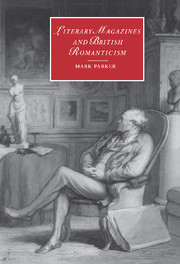Book contents
- Frontmatter
- Contents
- Acknowledgments
- Introduction: the study of literary magazines
- Chapter 1 Ideology and editing: the political context of the Elia essays
- Chapter 2 A conversation between friends: Hazlitt and the London Magazine
- Chapter 3 The burial of Romanticism: the first twenty installments of “Noctes Ambrosianae”
- Chapter 4 Magazine Romanticism: the New Monthly 1821–1825
- Chapter 5 Sartor Resartus in Fraser's toward a dialectical politics
- Conclusion
- Notes
- Bibliography
- Index
- Cambridge Studies in Romanticism
Introduction: the study of literary magazines
Published online by Cambridge University Press: 22 September 2009
- Frontmatter
- Contents
- Acknowledgments
- Introduction: the study of literary magazines
- Chapter 1 Ideology and editing: the political context of the Elia essays
- Chapter 2 A conversation between friends: Hazlitt and the London Magazine
- Chapter 3 The burial of Romanticism: the first twenty installments of “Noctes Ambrosianae”
- Chapter 4 Magazine Romanticism: the New Monthly 1821–1825
- Chapter 5 Sartor Resartus in Fraser's toward a dialectical politics
- Conclusion
- Notes
- Bibliography
- Index
- Cambridge Studies in Romanticism
Summary
This book seeks to do three things: to demonstrate that literary magazines should be an object of study in their own right, to argue that they are the preeminent literary form of the 1820s and 1830s in Britain, and to explore the ways in which literary magazines begin to frame a discussion of Romanticism. To do so, I have taken five instances from the four most prominent magazines of the time: the London Magazine from 1820 to 1821, the New Monthly from 1821 to 1825, Blackwood's Edinburgh Magazine from 1822 to 1825, and Fraser's Magazine from 1833 to 1834. The first two of these instances are more traditionally author-centered, treating Charles Lamb's Elia essays and William Hazlitt's Table-Talk essays in the London. The third comes from the pages of Blackwood's, whose “Noctes Ambrosianae” constitutes one of the great experiments within the form of the magazine. The fourth takes up the New Monthly, perhaps the most consciously and purposefully homogeneous of the great magazines. The final instance, the run of Fraser's containing Thomas Carlyle's Sartor Resartus, signals the limit to this period of intense creativity in magazine production and writing.
- Type
- Chapter
- Information
- Literary Magazines and British Romanticism , pp. 1 - 29Publisher: Cambridge University PressPrint publication year: 2001



